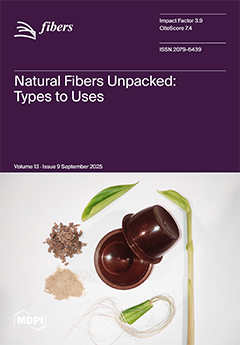This study aims to develop high-performance biocomposites for structural applications using kenaf, bagasse, hemp, and softwood fibers bonded with phenol-formaldehyde (PF) and phenol-urea-formaldehyde (PUF) adhesives, commonly used in particleboard manufacturing. A simple, low-cost fiber treatment was applied by adjusting the fiber pH to
[...] Read more.
This study aims to develop high-performance biocomposites for structural applications using kenaf, bagasse, hemp, and softwood fibers bonded with phenol-formaldehyde (PF) and phenol-urea-formaldehyde (PUF) adhesives, commonly used in particleboard manufacturing. A simple, low-cost fiber treatment was applied by adjusting the fiber pH to 11 and 13 using a 33% NaOH solution, following standard protocols to enhance fiber–adhesive interaction. The effects of alkaline treatment on the chemical structure of bagasse, kenaf, and hemp fibers were investigated using Fourier Transform Infrared Spectroscopy (FTIR) and correlated with composite mechanical performance. PF and PUF were applied at 13% (
w/
w), while polymeric diphenylmethane diisocyanate (pMDI) at 5% (
w/
w) served as a control for untreated fibers. The fabricated panels were evaluated for mechanical properties; modulus of elasticity (MOE), modulus of rupture (MOR), and internal bond strength (IB), and physical properties such as thickness swelling (TS) and water absorption (WA) after 24 h of immersion. FTIR analysis revealed that treatment at pH 11 increased the intensity of O–H, C–O–C, and C–O bands and led to the disappearance of the C=O band (~1700 cm
−1) in all fibers. Bagasse treated at pH 11 showed the most significant spectral changes and the highest IB values with both PF and PUF adhesives, followed by kenaf at pH 13, exceeding EN 312:6 (2010) standards for heavy-duty load-bearing panels in dry conditions. The highest MOE and MOR values were achieved with kenaf at pH 11, meeting EN 312:4 (2010) requirements, followed by bagasse, while softwood and hemp performed less favorably. In terms of thickness swelling, bagasse consistently outperformed all other fibers across pH levels and adhesives, followed by Kenaf and Hemp, surpassing even pMDI-based composites. These results suggest that high-pH treatment enhances the reactivity of PF and PUF adhesives by increasing the nucleophilic character of phenolic rings during polymerization. The performance differences among fibers are also attributed to variations in the aspect ratio and intrinsic structural properties influencing fiber–adhesive interactions under alkaline conditions. Overall, kenaf and bagasse fibers emerge as promising, sustainable alternatives to industrial softwood particles for structural particleboard production. PF and PUF adhesives offer cost-effective and less toxic options compared to pMDI, supporting their use in eco-friendly panel manufacturing. FTIR spectroscopy proved to be a powerful method for identifying structural changes caused by alkaline treatment and provided valuable insights into the resulting mechanical and physical performance of the biocomposites.
Full article





